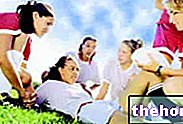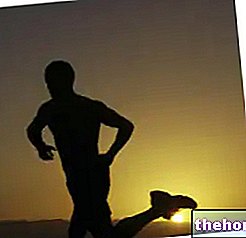Common low back pain: Recurrent idiopathic symptom / disease affecting the lumbar spine, characterized by pain and functional limitation.

Common low back pain accounts for 80% of low back pain cases. It is the most common disease in the working population and is the most common cause of absence from work in Western countries.
Types of lower back pain
Local: if caused by irritation of the nerve endings of the rachid musculoskeletal structures;
From defensive muscle contracture;
Radicular: by stretching, compression or irritation of the nerve root;
Reported: if it comes from extravertebral organs.
Risk factors for low back pain
The risk factors that predispose individuals to back pain are numerous: sedentary life, previous musculoskeletal trauma or caused by lifting heavy and bulky objects from the ground, the movements of pulling, pushing and rotating, the decrease in the strength of the trunk musculature, an imbalance between the anterior and posterior trunk muscles, loss of lumbar lordosis in the sitting position, precarious physical conditions, obesity, drug, drug and alcohol abuse.
Prevention of low back pain
Primary prevention (before the symptom arises): with an educational intervention that leads to learning correct lifestyle habits.
Secondary prevention (after its appearance): with a re-educational intervention by interpreting the subject's "pain".
History of the lumbago subject
Mode of onset, circumstances of worsening and improvement;
Type, severity, intensity, time and duration of pain;
Precise localization and irradiation of pain; concomitance with other symptoms;
Possible presence of connective, metabolic, cardiovascular, neurological, gastrointestinal diseases.
Guidelines for the rehabilitation of low back pain
Physical condition assessment;
Study of the anatomy of the spine;
Physical treatments for painful symptoms;
Streching, flexibility improvement and stabilization exercises;
Recovery of physical condition and muscular balance
Development of an exercise program to continue at home;
Education for a correct lifestyle to prevent trauma
Physical activity goals in a spine rehabilitation program
Maximize physical function
Improve muscle-tendon and tissue elasticity;
Balance muscle forces (with particular attention to the abdominal and lumbar groups);
Improve aerobic capacity and physical condition;
Ergonomics education in daily life activities.

Straight leg-raising sign (SLR): this movement evokes pain in the back or limbs and is similar to that complained of by the subject (L5, S1, sciatic)
Pain can be accentuated by dorsiflexion of the foot
The maneuver can also be performed with the patient seated
The abdominal muscles:
plays a fundamental role in the stabilization of the spine and, in relation to its topographical location, affects the lumbo-sacral tract in an important way.
The muscles of the abdominal wall act as stabilizers with synergistic action to the spinal muscles and that of the lower limbs (hip flexors / extensors, abductors / adductors of the thigh) which are inserted proximally on the pelvis, conditioning its balance.
Tonicity and trophism of the abdominal muscles
Necessary condition for correct movement dynamics;
It favors motor coordination and synergy between the muscles of the abdomen, those of the lower limbs and those of the spine, limiting the appearance of overload pathologies such as groin and back pain.
The abdominal muscles (rectus abdominis) limits and counteracts excessive hypertension of the lumbar muscles
A suitably reinforced abdominal belt allows you to unload about 40% of the weight on the lumbar vertebraeThe function of the rectum of the abdomen
The rectus abdominis is an antagonist of the paravertebral musculature which acts with an anteversion action on the pelvis and hypertension on the lumbar spine. The most common pathological situation is that which contrasts the hypotonia of the abdominal wall muscles with the hypertonia of the paravertebral one.
Function of the torso flexor and extensor muscles of the thighs
They rotate the pelvis in retroversion, therefore they have a "delordosizing action for the lumbar spine."
Their weakening involves an "anteversion of the pelvis and consequent accentuation of the lumbar lordosis.
Function of the torso extensor muscles and thigh flexors.
They tend to rotate the pelvis in anteroversion, therefore they have a "lordosing action for the lumbar spine."
By keeping them elastic you can counteract this action.
Respiratory technique
Breathe in during the passive phase of the exercise (body alignment), filling the lungs up to a little more than half; in this way in the next active phase (closing the body) it is possible to expel all the air;
Begin the exhalation phase from the beginning of the active phase of the movement (beginning of the closing of the body); in this way the diaphragm can rise immediately and does not hinder the closing of the trunk;
Strive to continue the exhalation in a constant way for the whole duration of the active phase of the movement; in this way the shortening of the affected muscles is constant;
Make sure you have completely emptied your lungs just before the end of the active phase of the movement, only in this way is it possible to be sure of obtaining the maximum muscle shortening and to have affected not only the abdominal muscles properly motor (oblique and / or rectum) but also the transversus muscle.
Techniques used for the treatment of low back pain
Mc Kenzie method;
Mézières method;
The back school
The Mc Kenzie method
It recognizes a mechanical and non-inflammatory cause in spinal disorders and identifies the predisposition to low back pain in two factors linked to lifestyle:
incorrect sitting position;
frequency of flexionThis method allows the therapist a "careful mechanical evaluation in order to identify two categories of patients; one that responds to self-treatment and prophylaxis techniques, the other that requires additional manual therapy."
The Mézières technique
It is based on the principle according to which it is necessary to stretch the muscles responsible for the static with eccentric isotonic contraction exercises, keeping the stretch as long as possible.
The eccentric isotonic contraction causes the stretching of all the connective tissue and, on a physiological level, causes an increase in the number of sarcomeres and the replacement of fibrous tissue.
It is also based on the principle that rigid muscles deform first and to a greater extent than elastic muscles.
The objectives that characterize it are: to inhibit the retroaction of the posterior muscles, to try to recall them in their entirety for motor activities, to take advantage of the exercises to correct the curves, to facilitate deep diaphragmatic inhalation.
The 3 principles of the Mézières technique
Since each individual is unique, it is necessary to treat the sick and not the diseases;
Since each individual is indivisible, each treatment must be global;
Each treatment can and must go back from the symptom to the cause of the disease.The Back School
It includes exercises of respiratory education, postural education, exercises of mobilization, stretching, decompression, stabilization and balance of the spine.
All exercises are done very slowly, following the rhythm of the breath.




























